You’ll crest a low ridge and the river will suddenly appear, curving like a green ribbon set into rust-colored rock, and you’ll want to stop. You can reach Horseshoe Bend easily from Flagstaff or Page, park at the marked lot, then walk the short trail to the rim for sweeping views and prime photos. Keep going—there’s geology, timing tips, safety advice, and nearby stops that’ll make the trip smoother and more rewarding.
History and Geology of Horseshoe Bend
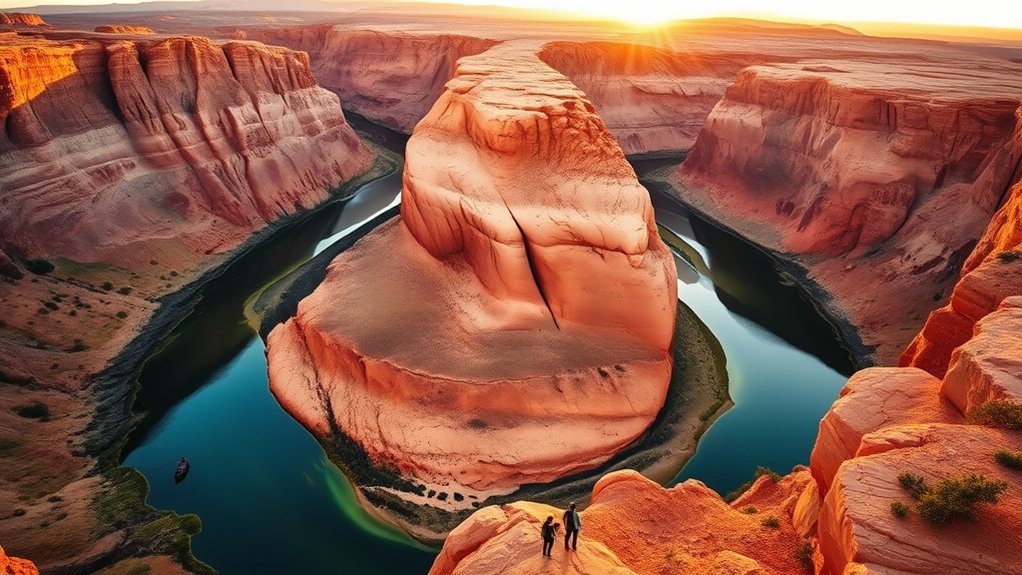
Though you might first see a dramatic cliff and a river loop, Horseshoe Bend tells a much older story: over millions of years the Colorado River actively carved a horseshoe-shaped meander through layers of sandstone, exposing rock that began as wind-blown dunes more than 100 million years ago. You’ll notice the canyon’s contours reflect relentless erosion, each stratum recording shifting climates and sediment. As a geological formation, Horseshoe reveals where water found the rock’s weakest seams and widened them into the sweep you now observe. Look for bedding planes, cross-strata, and color bands that map ancient deserts turned stone. Situated within Glen Canyon National Recreation Area, the site makes clear how time, gravity, and flowing water sculpt landscapes you can inspect and learn from.
How to Get There and Parking Details
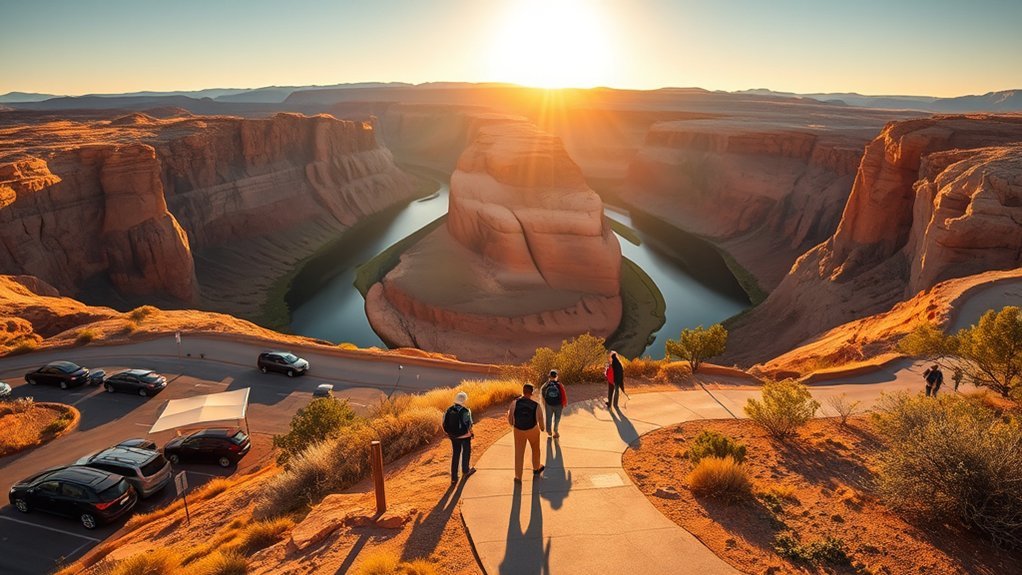
Getting to Horseshoe Bend is straightforward — you’ll take Highway 89 north from Flagstaff (about 125 miles) to the turnout at mile marker 544 near Page. There’s a large paid parking lot there ($10 per car, $5 per motorcycle), so plan to arrive early or midweek since spots fill fast and roadside parking isn’t allowed. From the lot you’ll walk a well-maintained 0.6-mile trail to the overlook, and note that drop-offs must follow the lot rules or your vehicle could be ticketed and towed.
Directions From Flagstaff
If you’re driving from Flagstaff, head north on Highway 89 for about 125 miles (roughly a two-hour drive) toward Page, keeping an eye out for the west-side parking lot at mile marker 544 before you reach town—parking along the highway is prohibited, so plan to use that lot. From there, follow the well-marked Horseshoe Bend Trail: it’s a 0.6-mile dirt path to the overlook, easy but exposed, so bring water and sun protection. The overlook frames the Colorado River’s dramatic meander through the Bend; it’s worth timing your visit to Horseshoe for softer light. Parking fills quickly during peak windows, so arrive early to secure a spot and allow time for the round trip walk and photos.
Parking Lot Fees
Plan to pay when you arrive: personal vehicles are charged $10 and motorcycles $5, while commercial vehicle rates vary by passenger capacity, and payment supports lot maintenance and visitor services. You’ll find the Horseshoe Bend parking lot on the west side of Highway 89, about 15 minutes from Page; it’s open year-round from sunrise to sunset. The parking fee is straightforward, paid at kiosks or via app, and helps keep trails and rest areas maintained. Lots fill fast during peak times — arrive at sunrise or on weekdays to avoid crowds. Don’t park on the highway: no roadside parking is allowed and violators get ticketed and towed. Plan your timing, pack water, and be ready for a short walk.
Drop-Off and Rules
Beyond paying the parking fee, you’ll need to follow strict drop-off and parking rules at Horseshoe Bend to avoid fines or towing. You’ll park only in the designated lot off Highway 89 — roadside parking and curbside drop-offs aren’t allowed. An emergency ordinance bans passenger drop-offs and pickups at the entrance, so plan where to meet if someone in your group needs a ride. The lot fills fast, especially 9–11 a.m. and 4:30–6:30 p.m., so arrive early; fees are enforced and cash may be required during busy periods. From the parking lot it’s a 0.6-mile walk to the fenced overlook, which is accessible for families and leashed dogs. Follow signs and attendants to avoid citations.
The Trail and Overlook Experience
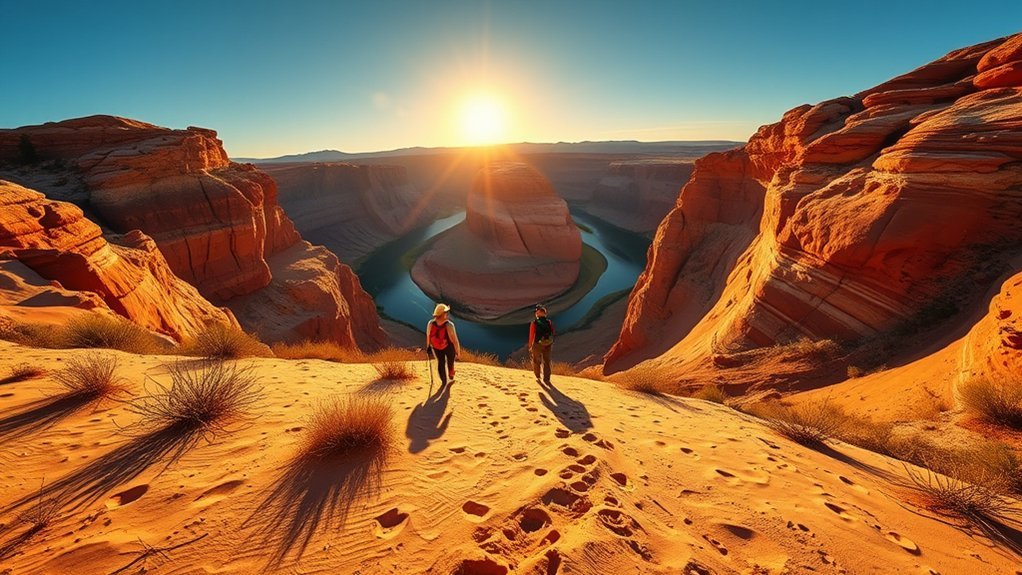
While the walk is short and mostly flat, you’ll still want to set a steady pace along the 1.5-mile round-trip dirt path that’s friendly to families, strollers, and leashed dogs. The trail to Horseshoe Bend takes about 20 minutes each way with roughly 150 feet of elevation gain; it’s easy but expect loose sand and occasional rocks. You’ll pass two shade structures—use them for a quick rest—but note the overlook itself has no shade. Once you reach the rim, step carefully: limited barriers and slick sandstone make the edge hazardous. The payoff is immediate: sweeping panoramic views of the Colorado River carving a horseshoe-shaped meander. Keep your distance from the drop-offs while you soak in the overlook and surrounding scenery.
Best Times to Visit and Photography Tips
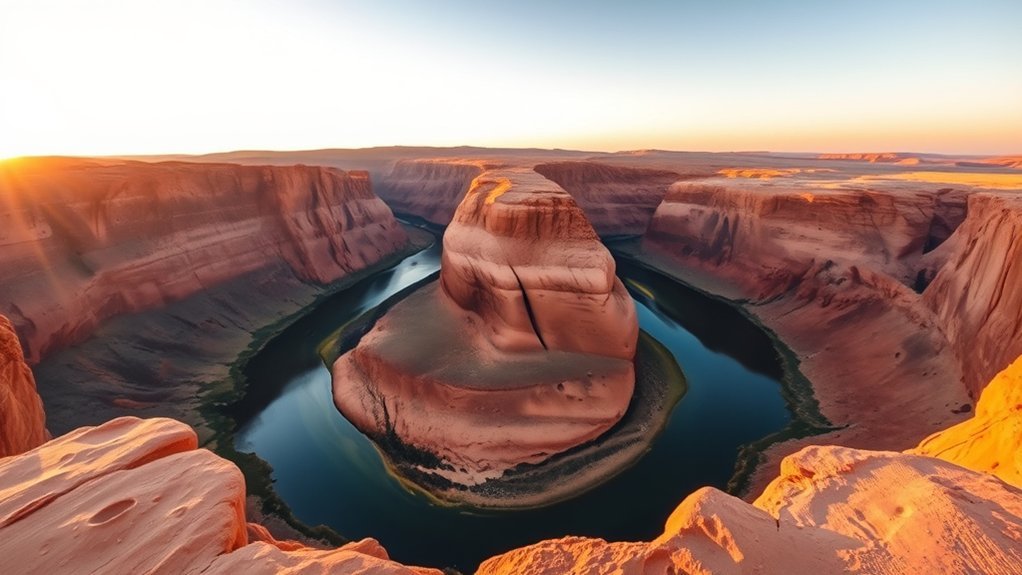
When should you time your visit for the best photos? Aim for early morning or late afternoon — the best time for ideal photography — when softer lighting enhances the canyon’s colors. Plan to arrive before peak visitation (9–11 a.m. and 4:30–6:30 p.m.) to avoid the crowds and claim a good vantage point.
For drama, shoot at sunrise or sunset; warm hues deepen the sandstone and create striking contrasts. Be aware that shadows from the canyon walls during those hours can alter composition, so move along the rim to find balanced light. Mid-morning to early afternoon offers visibility but often brings harsh sunlight that washes out colors, so try to photograph before 10 a.m. or after 3 p.m. for richer tones.
What to Bring and Safety Considerations
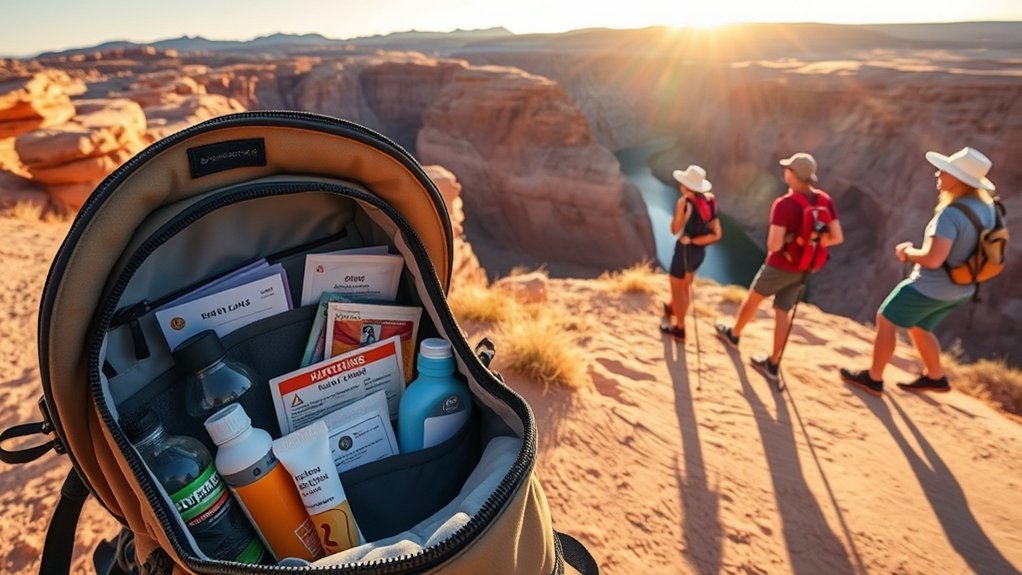
Bring at least a liter of water per person for every two hours of hiking and pack light snacks to keep your energy up on the trail. Wear closed-toe shoes, sunglasses, a wide-brimmed hat, and sunscreen to protect against the intense sun and variable weather. Stay well back from the slick sandstone edges—there are few barriers, so steady footing and caution are essential.
Water, Snacks & Hydration
Plan on carrying at least 1 liter of water per person for every two hours you’ll be on the trail, and pack light, energizing snacks to keep your pace steady on the 1.5-mile round trip. You’ll notice the desert air pulls moisture fast; sip frequently, don’t gulp. Balance water and electrolytes if it’s hot, and stash snacks where they’re reachable without stopping in exposed spots. Wear sunscreen and sunglasses, and use closed-toe shoes for traction near slick sandstone to protect yourself during the short hike.
| Item | Purpose |
|---|---|
| Water | Hydration between stops |
| Electrolytes | Prevent cramps |
| Snacks | Quick energy |
| Closed-toe shoes | Traction and safety |
| Sunglasses | Eye protection |
Watch for heat, adjust pace, and prioritize safety.
Sun Protection Essentials
You’ve already packed water, snacks, and sturdy shoes, so next focus on shielding yourself from the sun’s glare and heat while you hike to the overlook. In the exposed desert climate, sun protection is more than comfort—it’s essential. Slather a broad-spectrum sunscreen with high SPF before you set out and reapply after a couple hours, especially if you perspire. Wear a wide-brimmed hat to shade your face and neck; it also keeps you cooler as you walk. Sunglasses with UV protection cut glare off the canyon and reduce eye strain. Keep hydration front and center: plan at least 1 liter per person for every two hours, sip regularly, and monitor color of urine. Prefer closed-toe shoes for rocky sections.
Edge Safety & Footwear
Because the overlook has slick sandstone and steep drop-offs with few barriers, stay mindful of every step near the rim. Prioritize edge safety by keeping a low center of gravity, avoiding distractions while taking photos, and giving others space on narrow sections. Wear sturdy closed-toe shoes for traction on uneven, sometimes hot ground; flip-flops won’t protect you or your feet. Bring sun protection and water — plan for at least 1 liter per person for every two hours of hiking — and sip frequently to avoid heat stress. If you bring pets, leash them and check their paws often; the hot ground can burn quickly. Pack light, move deliberately, and respect the cliff’s limits to enjoy the view safely.
Nearby Attractions and Where to Stay
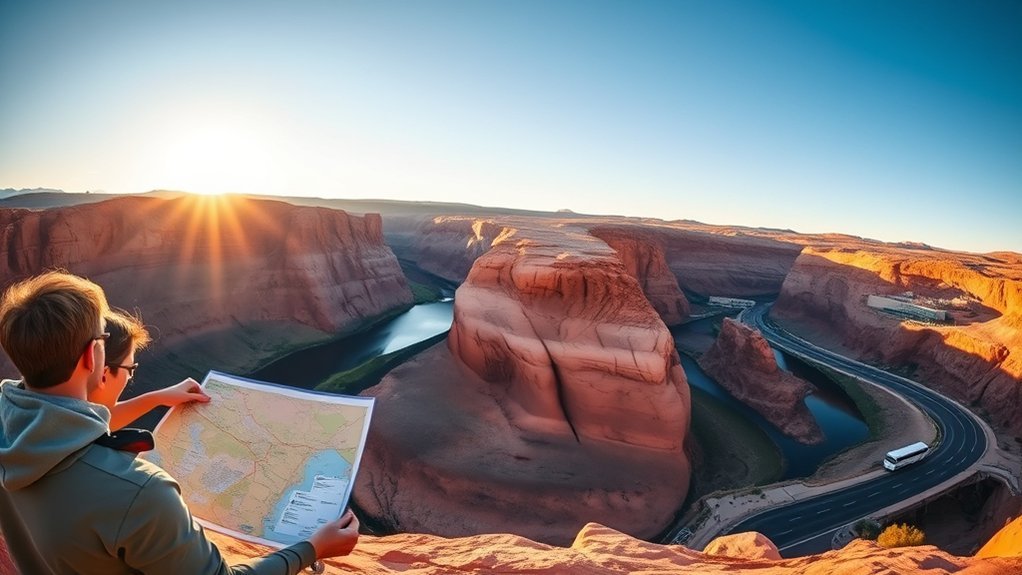
If you’re staying near Page, you’ll find more than 300 hotels and rentals within easy reach of Horseshoe Bend, from lakeside resorts to budget-friendly motels. Pick accommodations that match your plans: Lake Powell Resort at Wahweap Marina puts you on the water with an onsite restaurant and boat access, while Hyatt Place Page/Lake Powell offers modern rooms, pet-friendly options and free breakfast for early starts. For nearby attractions, plan short drives — Antelope Canyon’s slot canyons are about 15 minutes away for iconic photos, and Glen Canyon Dam sits roughly 10 minutes from the overlook. You’ll save time by basing yourself in Page, letting you hit sunrise at Horseshoe Bend, take a boat tour, or stroll the dam without long transfers.
Frequently Asked Questions
How Much Time Do You Need at Horseshoe Bend?
You’ll need about 1.5 hours for the hike and scenic viewpoints; add time for photography tips, parking, visitor amenities, spotting local wildlife, and safety precautions—schedule by time of day to avoid crowds and heat.
What’s the Best Time to See the Horseshoe Bend?
Like a painted clock, the best time to see Horseshoe Bend is early morning for sunrise views or late afternoon for sunset photography; account for seasonal crowds, weather conditions, and choose best months for cooler temps and softer light.
Can I See Horseshoe Bend Without a Tour?
Yes — you can visit Horseshoe Bend independently: Visiting independently is easy via the short trail. Observe Scenic viewpoints, follow Local regulations and Safety precautions, pick Best times for photography. Use Photography tips for dramatic shots.
Is Horseshoe Bend Worth the Trip?
Yes — you’ll be captivated. Expect epic scenic views, great photography tips opportunities at sunset experiences, easy hiking trails, basic visitor facilities, nearby local attractions, and manageable travel costs, so plan timing and arrive early for best results.
Conclusion
You’ll come for the postcard view and, ironically, leave having hiked a civilized 0.6-mile path to gaze at a billion-year-old river doing all the heavy lifting. You’ll time your visit for golden light, pack water and decent shoes, and still be surprised at how vast it feels from the safe overlook. It’s practical, photogenic, and quietly humbling — a blockbuster landscape that demands minimal effort and rewards you with maximum perspective.

